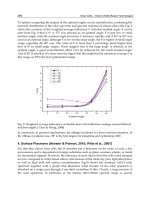Handbook of plant based biofuels - Chapter 12 ppt
Bạn đang xem bản rút gọn của tài liệu. Xem và tải ngay bản đầy đủ của tài liệu tại đây (234.94 KB, 6 trang )
Section III
Production of Biodiesel
© 2009 by Taylor & Francis Group, LLC
177
12
Biodiesel
Current and Future
Perspectives
Milford A. Hanna and Loren Isom
AbstrAct
Biodiesel, a fuel comprised of mono-alkyl esters of long chain fatty acids derived
from vegetable oils, animal fats, or mixtures thereof, is produced by transesteri-
cation, with glycerol being produced as a co-product. Worldwide, 1 billion tons of
diesel fuel are consumed annually. The total feedstocks available for food, feed, and
industrial applications are 115 million tons. This represents less than 12% of diesel
fuel use. The opportunities for the future for biodiesel include improvements in the
conversion technology, which appears promising, and expanding the amount of avail-
able feedstock through various plans to increase oil yields or oilseed production.
12.1 IntroductIon
Biodiesel, a fuel comprised of mono-alkyl esters of long chain fatty acids derived
from vegetable oils, animal fats, and mixtures thereof, is produced by transesteri-
cation, with glycerol being produced as a co-product. Overall, the energy ratio for
biodiesel production is in the range of 3.2 to 3.6 (Sheehan et al. 1998). Blending biod-
iesel with diesel fuel offers improved lubricity and reduced emissions. Worldwide,
one billion tons of diesel fuel are consumed annually (Hanna, Isom, and Camp-
bell 2005). The total feedstocks produced that can be used, competitively, for food,
feed, and industrial applications are approximately 115 million tons. Assuming a 1:1
contents
Abstract 177
12.1 Introduction 177
12.2 Diesel Fuel Markets 178
12.3 Biodiesel Standards 178
12.4 Biodiesel Feedstocks 178
12.5 Opportunities 179
12.6 Conclusions 180
References 181
© 2009 by Taylor & Francis Group, LLC
178 Handbook of Plant-Based Biofuels
conversion on a weight basis, this represents a maximum of 12% of diesel fuel use
(Hanna, Isom, and Campbell 2005). The opportunities for the future for biodiesel
include improvements in the conversion technology, expanding the amount of avail-
able feedstock, and adding value to the glycerol by-product.
12.2 dIesel fuel mArKets
Diesel fuel use worldwide is estimated to be 1.14 billion tons (330 billion gallons)
per year. The United States uses an estimated 18% of that, or 205 million tons (60
billion gallons) (USEIA 2004). Because diesel (compression ignition) engines are
more efcient than gasoline (spark ignition) engines (45% versus 30%), there is the
possibility that the use of diesel engines in vehicles will increase, thereby increasing
the demand for diesel fuel (DOE 2003).
12.3 bIodIesel stAndArds
If biodiesel is to be accepted as a fuel for diesel engines, it will have to be produced
and handled in such a way that the variations in its properties and its performance
characteristics will be less than, or equal to, what the consumer is used to with
(petroleum-based) diesel fuel. A single, widely accepted standard for biodiesel is not
available. Instead, the standard ASTM D6751 was developed for the United States,
the CEN EN14214 Standard was developed for the European Union (EU), and other
regions also have established alternative standards. One effort being made to ensure
biodiesel fuel quality is the National Biodiesel Boards BQ 9000 certication pro-
gram. Numerous producers and marketers have been certied.
12.4 bIodIesel feedstocKs
The annual production of biodiesel is increasing rapidly worldwide, from 10 thou-
sand tons (4 million gallons) in 2000 to 3.5 million tons (1 billion gallons) in 2005
(Gubler 2006; EBB 2006). In the United States, most new production assumes that
soybean oil will be the oil of choice, with animal fats coming in as a distant second
choice.
Soybean production in the United States was 81.8 million tons (3 billion bushels)
in 2005 (Ash and Dohlman 2006). Even though soybean oil is the single most avail-
able oil worldwide, predicting a signicant increase in soybean production in the
United States seems to be in conict with the projected increase in ethanol produc-
tion and the concomitant increase in corn production. Typical yields, on a per hectare
basis, would be 568 l (150 gallons) of biodiesel based on 18% oil content from 2.9
tons/ha of soybeans (43 bu/ac) at a 1:1 conversion rate of oil to biodiesel versus 3,760
l (1,000 gallons) of ethanol based on a yield of 9.4 tons/ha of corn (150 bu/ac) at a
conversion rate of 400 l (106 gallons) per ton of corn (2.7 gallons/bu). The 2.4 tons/
ha of soybean meal remaining after oil extraction will have to compete for market
share with the 2.9 tons/ha of distillers grain remaining after fermentation of corn
starch to ethanol.
© 2009 by Taylor & Francis Group, LLC
Biodiesel: Current and Future Perspectives 179
Although soybean oil currently is the feedstock of choice in the United States
and Brazil, it is not an obvious feedstock for biodiesel production from a global per-
spective. Other materials (oil palm in Southeast Asia, jatropha in India, rapeseed in
Eastern Europe, and crops such as sunowers, camelina, and hazelnuts in the United
States) have greater potential on an oil yield basis (Kurki, Hill, and Morris 2006).
Of course, various oilseed varieties have preferred growing conditions and in most
cases are not widely adaptable.
Animal fats are a viable feedstock for biodiesel production but are available, in
large quantities, on a very limited basis. Total fat production is estimated at 15 mil-
lion tons per year worldwide (Rossell 2001). Again, assuming a 1:1 conversion on a
weight basis, all of the animal fat worldwide could replace less than 2% of the diesel
fuel used on an annual basis.
The demand for vegetable oils and animal fats for biodiesel production will
quickly deplete any surpluses. The demands represented by competing uses,
primarily food, will result in increased feedstock prices, which are known to be the
single largest cost in biodiesel production.
The forecasts for worldwide biodiesel demand and the production capacity vary
greatly, reecting the rapid development associated with this industry. SRI Consult-
ing’s Marketing Research Report on biodiesel (Gubler 2006) forecasts the worldwide
demand will surpass 40 million tons and the production capacity will surpass 80
million tons by 2010. Another study, Biofuel Market Worldwide (2006), estimated
that worldwide biodiesel production would continue to grow rapidly and would reach
11 million tons (3.17 billion gallons) by 2010. Considering the variance in these
forecasts, it is difcult to estimate a specic rate of growth. However, it is clear that
extreme pressure will be exerted on the available feedstock. The feedstock supplies
will need to expand beyond the estimated 115 million tons currently produced, or
biodiesel production costs will rise, thus reducing its competitiveness with petroleum
diesel and increasing its dependence on government incentives.
12.5 opportunItIes
The feedstock accounts for 70% to 80% of the cost of biodiesel production, and
clearly is the key factor to evaluate when considering the competitiveness of biod-
iesel with petroleum-based diesel fuel. However, within the biodiesel industry, the
processing technologies will play a key role in determining industry leaders and
maximizing protability. By-product utilization will be another key factor as the
rapid expansion of the biodiesel industry has greatly outpaced glycerin markets at
both the crude- and pharmaceutical-grade levels.
Raw material availability for biodiesel production, worldwide, is signicant.
Additional sources include expanded oilseed production, higher oil content variet-
ies, and higher oil content crops. In the United States, it is estimated that expanding
oilseed production by releasing 4 million hectares of productive land from gov-
ernment set-aside programs and switching another 8 million hectares from export
grains could produce additional vegetable oil feedstocks of 2.1 million and 4.2 mil-
lion tons, respectively. If the average soybean oil yield could be increased to 20%,
versus the current 18%, which has been proven possible with several improved vari-
© 2009 by Taylor & Francis Group, LLC
180 Handbook of Plant-Based Biofuels
eties, an additional 800 thousand tons of vegetable oil would be available. Or if
future improvements could increase oil yields to an average of 22% oil, an additional
1.6 million tons would be available. If the oil demand outpaces the protein demand,
the soybean production could be replaced with higher yielding oil crops such as
sunower and canola, which produce as much as 500 l/ha more oil than soybeans.
Assuming soybean production at 29 million hectare and a 20% conversion to higher
yielding oil crops, an additional 2.6 million tons would be available. Overall, the
conversion of all existing and potential feedstocks in the United States will not be
able to generate more than 12% of the domestic diesel demand. Therefore, it seems
reasonable to project that biodiesel will be consumed primarily in niche markets:
20% biodiesel blends for emission benets and 5% or lower blends as a lubricity
additive in ultra-low-sulfur diesel fuel (Hanna, Isom, and Campbell 2005).
New processing technologies are anticipated to improve operating efciencies.
The most signicant improvement is expected to come from the use of heterogeneous
catalysts systems. Such catalysts have the potential to eliminate the need for water
washing to remove the excess catalysts, thus, reducing both capital and operating
costs. It also is perceived that the free fatty acids present in feedstocks can be con-
verted concurrently to alcohol esters rather than being separated out and used for
the lower value purposes. Yet another potential advantage is that a higher quality
glycerol will be obtained.
Glycerol, a co-product of biodiesel production, has many commercial uses. The
current oversupply of glycerin may make it a burden to the industry in the near term
until new markets are developed for crude glycerin, or alternative markets are devel-
oped for rened glycerin. If cost-effective markets are not available, the disposal
costs could be signicant. In the long run, the most protable facilities will identify
the markets to capture the signicant value from the glycerin by-product. Currently,
the opportunity most often cited is that of using the glycerol to produce 1,4-propane-
diol, a commodity chemical and a precursor for many products.
Adding value to other co-products of biodiesel production, or at least maintain-
ing their current values, will enhance the economic viability of the biodiesel industry.
The oilseed meals/press cakes are used predominately as animal feeds. Their values
as feeds, or feed supplements, are functions of their protein content and quality and
the need for additional processing to inactivate or remove the anti-growth factors
such as trypsin inhibitors and glucosinolates. Opportunities for adding value to the
meals include industrial uses for the proteins, such as adhesives, and the extraction
of higher value materials, such as policosanols.
12.6 conclusIons
The opportunities for expanded biodiesel production are great considering the high
demand for petroleum-based products in both the industrialized and the develop-
ing regions of the world. The increased awareness of the negative environmental
factors associated with petroleum fuels and a desire to move to renewable fuels has
caused signicant growth in the biodiesel industry. However, it represents only a
small fraction of the current diesel fuel demands. Even as biodiesel production and
available feedstocks expand, that growth will be challenged to keep pace with the
© 2009 by Taylor & Francis Group, LLC
Biodiesel: Current and Future Perspectives 181
growing demand for fuel. Biodiesel feedstock availability, the price, and the result-
ing by-products, combined with government incentives for economic or environ-
mental issues, ultimately will determine the competitiveness of biodiesel as a direct
substitute for petroleum diesel. It is anticipated that biodiesel will drive the industrial
applications for vegetable oils and animal fats but will not displace the food applica-
tions which will continue to determine the vegetable oil price for the most desirable
oils, while the lower grade oils will become the industrial feedstocks. The conver-
sion technologies will continue to improve and will allow government incentives to
be phased out as the biodiesel feedstock supplies and the prices balance out com-
pared to petroleum diesel prices and supplies. The trend toward the development of
larger production facilities and consolidation of ownership is expected to continue as
the competition for the feedstock supplies and fuel markets increase.
references
Ash, M. and E. Dohlman. 2006. Oil Crops Outlook. Washington, DC: United States Depart-
ment of Agriculture, OCS-06j, />OCS-11-13-2006.pdf (accessed May 2008)
Biofuel Market Worldwide. 2006. RNCOS, Research & Markets, Ireland, http://www.
researchandmarkets.com/reports/340050 (accessed May 2008)
DOE (Department of Energy). 2003. Just the Basics: Diesel Engine. Washington, DC: U.S.
Department of Energy. />diesel_engine.pdf (accessed May 2008)
EBB (European Biodiesel Board). 2006.
(accessed May 2008)
Gubler, R. 2006. Marketing Research Report – Biodiesel. SRI Consulting.
Hanna, M., L. Isom, and J. Campbell. 2005. Biodiesel: Current perspectives and future. Jour-
nal of Scientic & Industrial Research 64: 854–857.
Kurki, A., A. Hill, and M. Morris. 2006. Biodiesel: The Sustainability Dimensions. National
Sustainable Agriculture Information Service. />biodiesel_sustainable.pdf (accessed May 2008)
Rossell, B. 2001. Oils and Fats. Vol. 2. Animal Carcass Fats. Leatherhead Food Interna-
tional. (accessed May 2008)
Sheehan, J., V. Camobreco, J. Dufeld, M. Graboski, and H. Shapouri. 1998. An Overview
of Biodiesel and Petroleum Diesel Life Cycles. NREL/YP-580-24772. Golden, CO:
National Renewable Energy Laboratory.
USEIA (United States Energy Information Administration). 2004. World Apparent Consumption
of Re ned Petroleum Products – 20 03, International Energy Annual 2004. Washington,
D.C:USEIA. (accessed
May 2008)
© 2009 by Taylor & Francis Group, LLC









